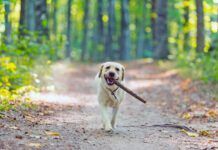On occasion, an adult dog who has been trustworthy with his chewing habits may suddenly surprise you with an oral foray into the forbidden.
This may be a stress response to something environmental happening in your absence, such as a burglar trying to break into your home, loud equipment working in the street in front of your house, or stray dogs romping through your yard. Sometimes even something like a compelling need to urinate or defecate can stress a well-trained dog into inappropriate chewing.
If you can determine the nature of the stressor and control or remove the cause, your dog should quickly revert to his prior good chewing behavior. He might also need a refresher course in the crate, after a veterinary exam to rule out possible medical causes. (Anytime there’s a significant behavior change in an adult dog it’s important to rule out – or treat – any possible medical contributors to the undesirable behavior.)
A return to inappropriate chewing may be a result of inactivity and pent-up energy. Perhaps the weather’s been bad or your workload extra heavy, curtailing your normal exercise sessions with your canine companion. That energy has to go somewhere – and for some dogs, it goes right to their jaws. The solution here is a renewed commitment to provide adequate exercise, with the addition, perhaps, of mental exercise into your dog’s daily routine.
For more details and advice on ways to prevent and cure destructive chewing habits, purchase Whole Dog Journal’s ebook, Simple Ways to Prevent and Cure Destructive Chewing.




